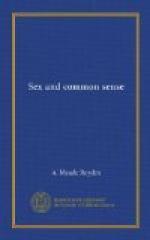It has become almost a habit with me to feel that the real solution of every problem can be found, by those people who are hurt by it, if they will take hold of life where it hurts, and find out, not how they themselves can escape from that hurt, but how they can prevent that hurt from becoming a permanent factor in the lives of their brothers and sisters. Now, the point at which this problem hurts many of us lies in this, that women have been taught, by a curious paradox, first of all that they ought not to have any sexual feeling, any hunger, any appetite at all on that side of their natures; and secondly, that they exist solely to meet that particular physical need in men. The idea that woman was created, not like man, for the glory of God, but for the convenience of man, has greatly embittered and poisoned public opinion on this subject. Women are taught, almost from the moment they come into the world, that their chief end in existence is to be, in some way or other, a “helpmeet” for man. I remember, in the early days of the Suffrage struggle, hearing people, and women quite as often as men—more often I think—urging certain rights and principles for women, on the ground that they were meant to be the helpmeets of man. They used to quote the earlier chapters of the Book of Genesis to show that women were created for that purpose; and it was considered a very lofty kind of appeal. I think it never failed to evoke the applause of those whom you will forgive my calling a little sentimental. I do not think it ever failed to arouse in myself a deep sense of resentment. The writer of the first chapter of the Book of Genesis speaks of humanity as being created in the image and likeness of God, “male and female created He them”; there is no suggestion here that one sex was simply to be the servant of the other. That occurs in the second chapter. The idea is persistent; it is, of course, much older than the Old Testament. And it persists right into the New Testament, where you hear a man of the intellectual and spiritual calibre of St. Paul affirm that man was made for God, but woman was made for man. Down the ages this message has come, and women have been taught to consider themselves, and men to consider them, as primarily instruments of sex, of marriage and motherhood, or of other forms of serving men’s needs. You do not find that feeling in Christ’s attitude towards women. When people speak as though it were one of the weaknesses of Christianity that it appeals, or seems to appeal, more to women than to men, I ask you to believe that sometimes consciously, often quite unconsciously, women respond with passionate gratitude to Christ, because of His sublime teaching that every human soul was made for God, and that no part or section of society, no race, no class, and no sex, was made for the convenience of another.




